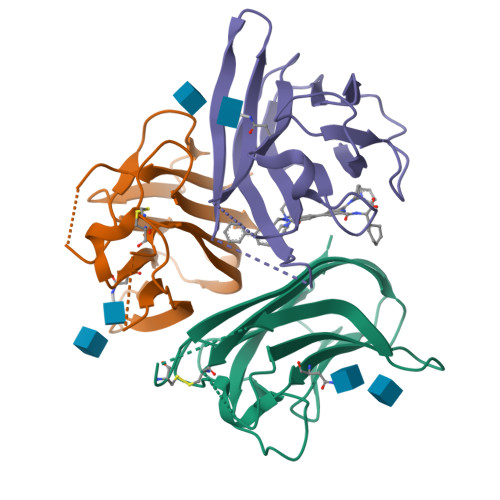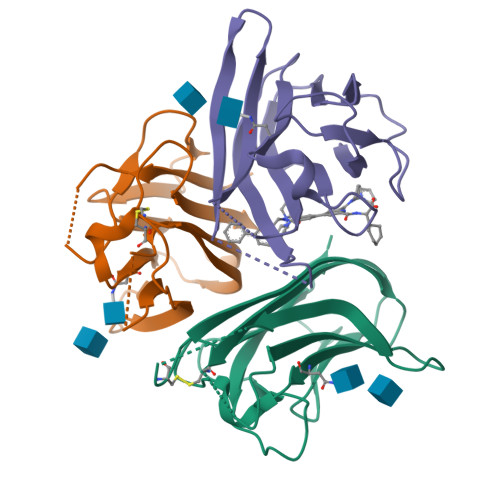Small Molecule Inhibition of the TNF Family Cytokine CD40 Ligand through a Subunit Fracture Mechanism.
Silvian, L.F., Friedman, J.E., Strauch, K., Cachero, T.G., Day, E.S., Qian, F., Cunningham, B., Fung, A., Sun, L., Su, L., Zheng, Z., Kumaravel, G., Whitty, A.(2011) ACS Chem Biol 6: 636-647
- PubMed: 21417339
- DOI: https://doi.org/10.1021/cb2000346
- Primary Citation of Related Structures:
3LKJ - PubMed Abstract:
BIO8898 is one of several synthetic organic molecules that have recently been reported to inhibit receptor binding and function of the constitutively trimeric tumor necrosis factor (TNF) family cytokine CD40 ligand (CD40L, aka CD154). Small molecule inhibitors of protein-protein interfaces are relatively rare, and their discovery is often very challenging. Therefore, to understand how BIO8898 achieves this feat, we characterized its mechanism of action using biochemical assays and X-ray crystallography. BIO8898 inhibited soluble CD40L binding to CD40-Ig with a potency of IC(50) = 25 μM and inhibited CD40L-dependent apoptosis in a cellular assay. A co-crystal structure of BIO8898 with CD40L revealed that one inhibitor molecule binds per protein trimer. Surprisingly, the compound binds not at the surface of the protein but by intercalating deeply between two subunits of the homotrimeric cytokine, disrupting a constitutive protein-protein interface and breaking the protein's 3-fold symmetry. The compound forms several hydrogen bonds with the protein, within an otherwise hydrophobic binding pocket. In addition to the translational splitting of the trimer, binding of BIO8898 was accompanied by additional local and longer-range conformational perturbations of the protein, both in the core and in a surface loop. Binding of BIO8898 is reversible, and the resulting complex is stable and does not lead to detectable dissociation of the protein trimer. Our results suggest that a set of core aromatic residues that are conserved across a subset of TNF family cytokines might represent a generic hot-spot for the induced-fit binding of trimer-disrupting small molecules.
Organizational Affiliation:
Department of Drug Discovery, Biogen Idec, 12 Cambridge Center, Cambridge, MA 02142, United States. laura.silvian@biogenidec.com.




















